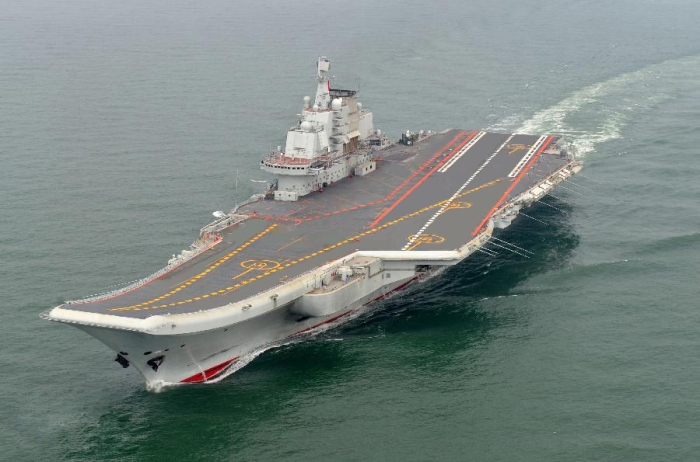Key Facts
| Builder | Nikolayev South Shipyard, Russia |
| Refit | CSIC Dalian Shipyard, China |
| Laid down | 6 December 1985 |
| Launched | 4 December 1988 |
| Completed | 2011 |
| Commissioned | 25 September 2012 |
| Displacement | 53,050 tonnes (standard) |
| Aircraft carried | Shenyang J-15 (Flanker-D) carrier-based fighter X24 Changhe Z-8 ASW X6 Kamov Ka-31 (Helix) AEW X4 Harbin Z-9G SAR X2 |
History
Varyag is the second hull of the Soviet Navy Project 1143.5 (Admiral Kuznetsov class) aircraft carrier. The 67,500-tonne vessel was laid down at the Nikolayev South Shipyard (formerly Shipyard 444) in Nikolayev on 6 December 1985 and was launched on 4 December 1988. In July 1990, the vessel was renamed Varyag. After the dissolution of the Soviet Union in 1991, the ownership of the vessel was transferred to Ukraine. Construction stopped by 1992 due to a lack of funding. By then, 70% of the construction had been finished. The vessel was structurally completed but without weapons, electronics, or propulsion.China first expressed interest in purchasing Varyag in 1992 and Chinese officials inspected the vessel stationed at the dock of the Nikolayev South Shipyard. However, the two sides could not agree on the price. The unfinished Varyag remained at the dock unattended for six years. In the late 1990s, the vessel was put up for auction and it was bought by a Macau-based Chinese company for US$20 million for conversion into a floating Casino and amusement park. The contract with Ukraine prohibited the buyer from using the carrier for military purposes. Before handing the ship over, the Ukrainians removed any equipment onboard Varyag that could be used to turn the vessel into a commissionable warship.
Varyag left the dock of the Nikolayev South Shipyard in 1999, towed by several high-power tug boats. However, the Turkish government refused the vessel to pass through the Bosporus Strait on the ground that the unpowered vessel posed too much risk for other ships as well as facilities in the strait. The vessel was stationed near the strait for three years until the Chinese government intervened and handed the Turkish government US$1 million as a guarantee bond.
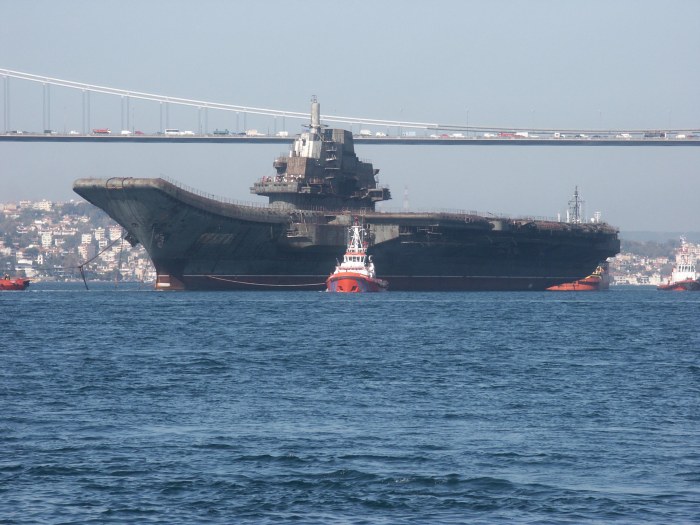
Varyag towed by tugs crossing the Bosporus Strait
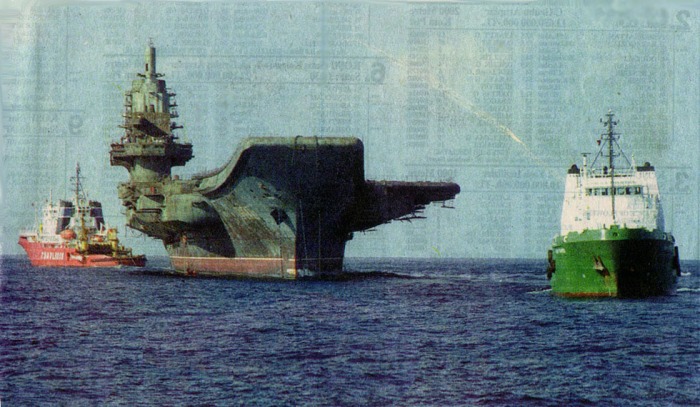
Varyag during its voyage to China. It arrived at the Dalian Shipyard in March 2002
The restoration work was completed in late 2006. The aircraft was then moved to another dry dock in April 2009 to install engines and other heavy equipment. System installation commenced in late 2010. By March 2011 the island of the aircraft carrier was almost complete, with painting finished and scaffolding removed.
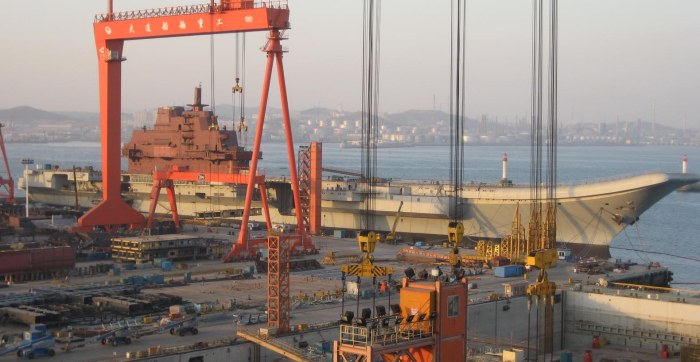
Varyag under refit at the Dalian Shipyard
On 25 September 2012, the aircraft carrier was officially commissioned by the PLA Navy, with a new name Liaoning and hull number 16. In November, the Ministry of National Defence confirmed that Chinese navy J-15 fighters had successfully performed touch-and-go and arrested landings on the Liaoning. Chinese press estimated that crew training would continue for 4 to 5 years before the aircraft carrier reaches its full capacity.
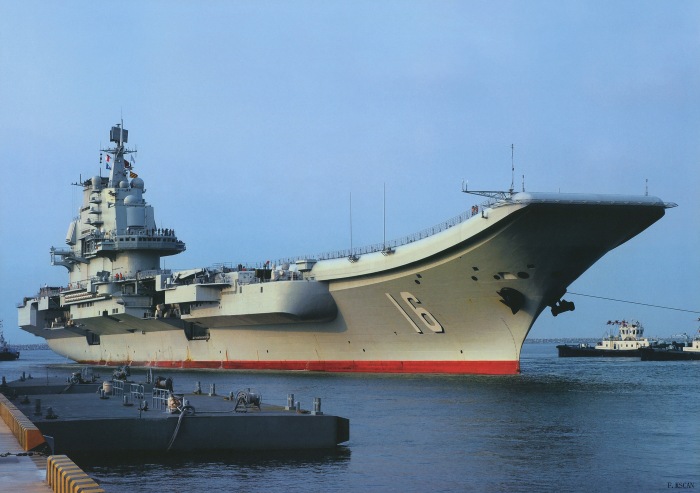
Varyag was commissioned by the PLA Navy on 25 September 2012 and renamed Liaoning
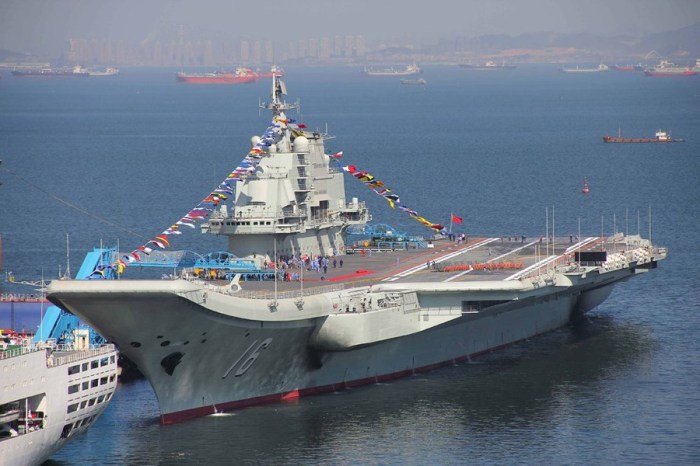
Liaoning aircraft carrier
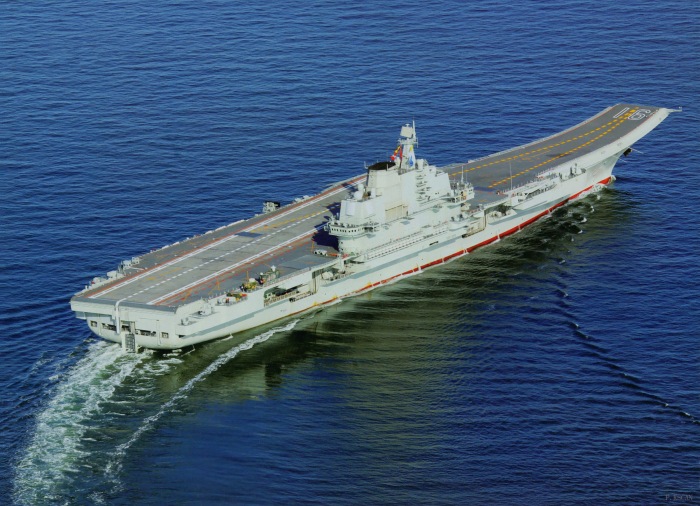
Liaoning aircraft carrier in sea trial
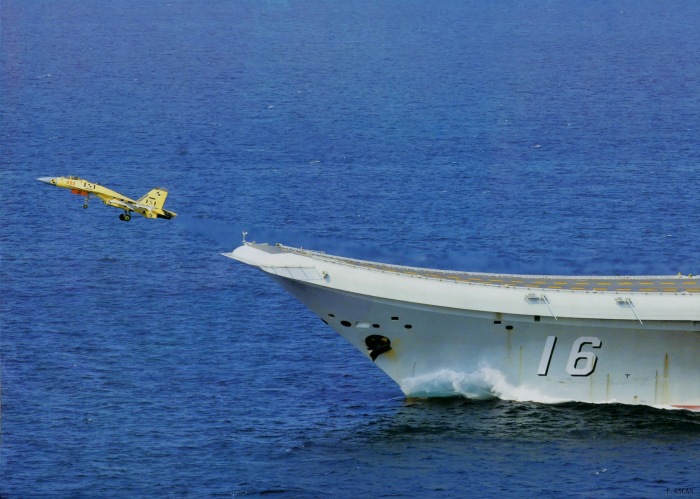
J-15 fighter taking off from the ski-jump deck of Liaoning
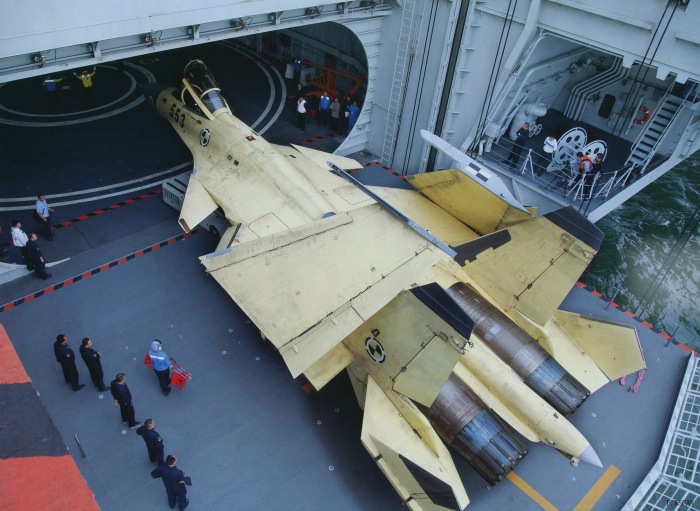
Two elevators lift the aircraft between the flight deck and the aircraft hangar
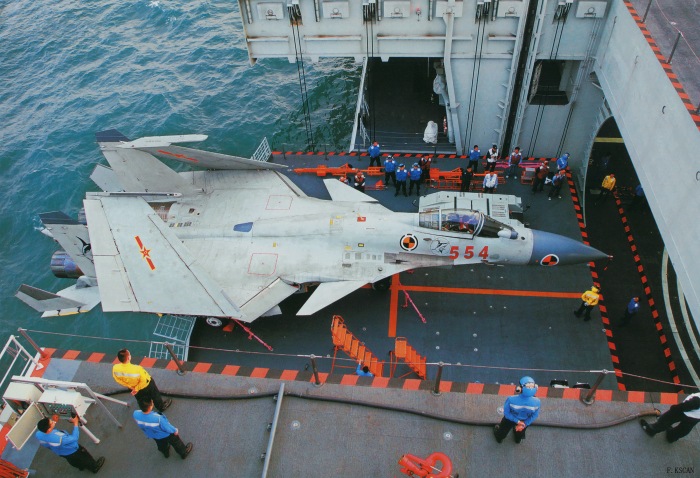
Aircraft elevator on the Liaoning
Aircraft
The Liaoning features a short take-off but arrested recovery (STOBAR) arrangement. Aircraft take-off is assisted by a bow ski-jump angled at 14°. The flight desk is fitted with arresting wires. Two starboard lifts carry the aircraft from the hangar to the flight deck.The Liaoning is expected to operate 24 Shenyang J-15 (Flanker-D) multirole fighters, 4 Kamov K-31 (Helix) or Changhe Z-18 AEW helicopters, 6 Changhe Z-8 ASW helicopters, and 2 Harbin Z-9G SAR helicopters.
See also: PLA Navy use JL-9 for carrier pilot training
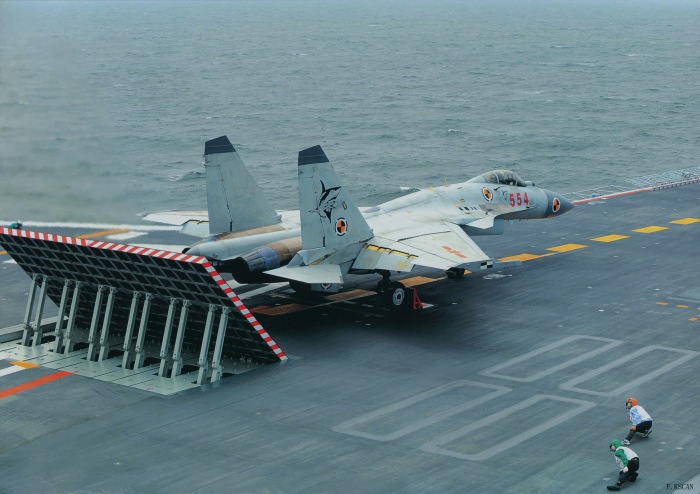
J-15 fighter preparing to take off
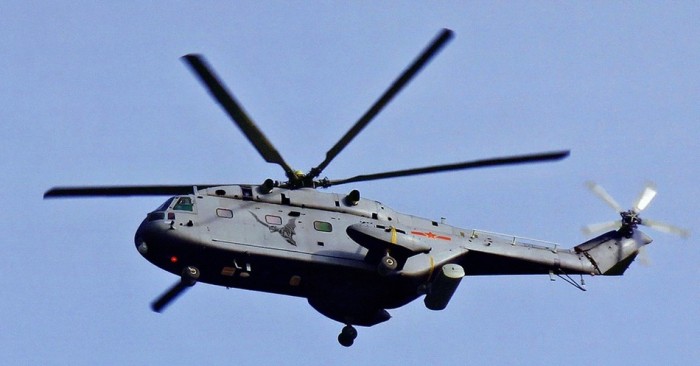
Z-18 airborne early warning helicopter was based on the Changhe Z-8 (Aérospatiale SA 321 Super Frelon)
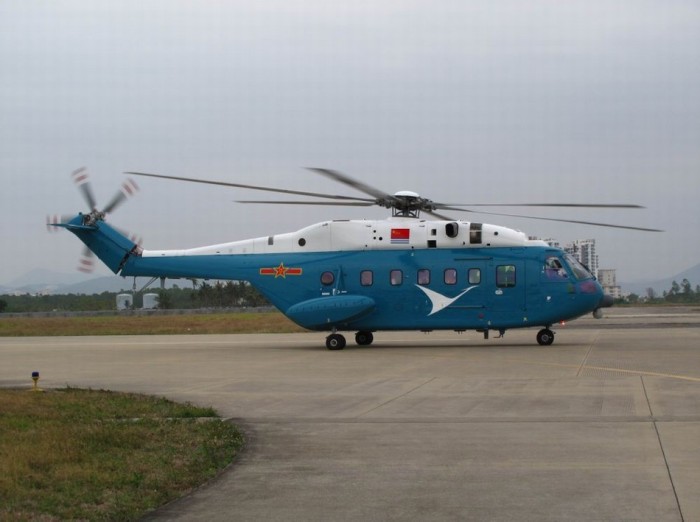
Z-8 transport helicopter is used to ferry pilots and officers between land base and the carrier
Weapons
The Varyag was originally to be fitted with a Granit (SS-N-9 Shipwreck) anti-ship missile system. The missile launcher was removed before the vessel was sold to China. The launcher base was removed during the refit to give a larger aircraft hangar space.For short-range air defence, the Liaoning is fitted with four HQ-10 (FL-3000N) air-defence missile systems, each with an 18-cell missile launcher. The missile launcher is similar to the U.S. Navy RIM-116 in arrangement. Derived from the TY-90 short-range air-to-air missile, the HQ-10 is fitted with a dual passive radar-/infrared-homing seeker and has a maximum range of 9,000 m. An improved variant is reportedly fitted with an independent active infrared seeker, with a maximum range of 10,000 m.
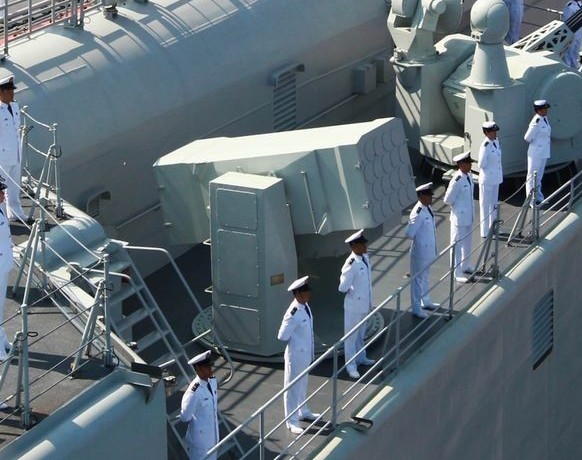
HQ-10 short-range air-defence missile system. The Liaoning is equipped with four 18-cell launchers.
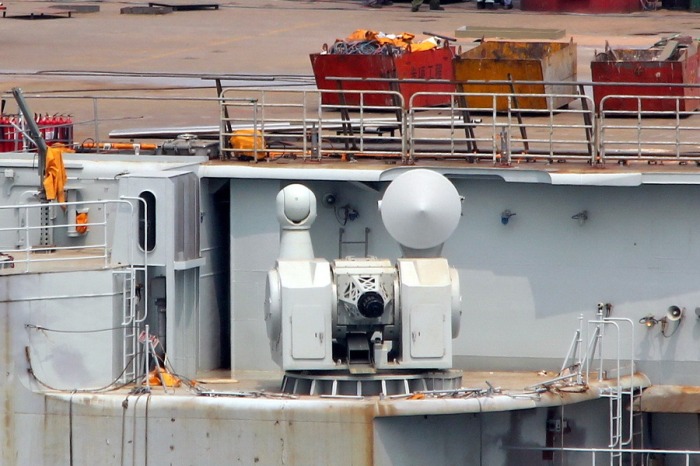
Type 1030 close-in weapon system, two of which are installed on the Liaoning
Sensors
Sensors spotted on the Liaoning include a Type 382 Sea Eagle S/C air-search radar and a set of four active electronically scanned array (AESA) radar panels. The Sea Eagle S/C radar is capable of tracking 10 targets simultaneously.Propulsion
The Liaoning is conventionally powered, possibly using a propulsion system similar to that of the Russian Navy Kuznetsov, consisting of eight boilers and four steam turbines (50,000hp each). The vessel is fitted with four shafts with fixed-pitch propellers.Specifications
| DIMENSIONS | |
| Length | 304.5 m |
| Beam | 75 m |
| Draft | 8.97 m |
| Displacement | 53,050 t (standard) 59,100 t (full-load) |
| PERFORMANCE | |
| Powerplant | Steam turbines |
| Speed | N/A |
| Range | N/A |
| Endurance | N/A |
| Complement | 1960 crew 626 air group |
| ARMAMENTS | |
| Guns | Type 1030 CIWS X3 |
| Missiles | FL-3000N SAM (18-cell) X3 |
| AIRCRAFT | |
| Fixed-wing | Shenyang J-15 X24 |
| Helicopters | Changhe Z-8 ASW X6 Kamov Ka-31 AEW X4 Harbin Z-9G SAR X2 |
Credit SinoDefence
